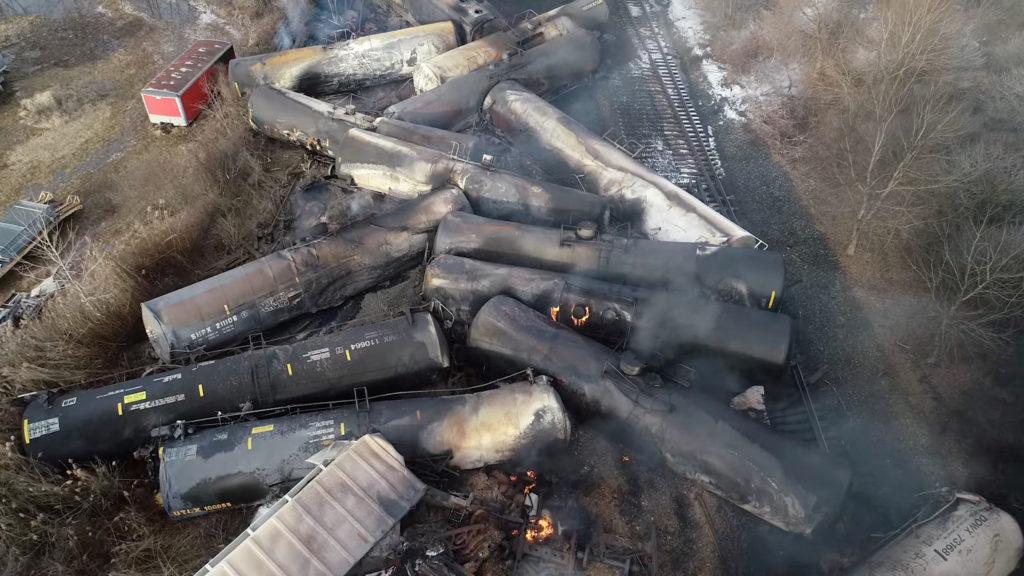The Lingering Threat: Toxic Chemicals From The Ohio Derailment And Building Contamination

Table of Contents
The Toxic Cocktail Released in East Palestine
The Norfolk Southern train derailment released a dangerous cocktail of toxic chemicals into the environment. Understanding the nature of these chemicals is crucial to assessing the long-term risks.
Identifying the Chemicals
Several hazardous chemicals were released, posing significant threats to human health and the environment. Key chemicals include:
- Vinyl Chloride: A known human carcinogen, vinyl chloride is linked to liver cancer, brain cancer, and other serious health problems. Exposure can also cause respiratory issues and circulatory disorders. Long-term exposure presents a particularly severe risk.
- Butyl Acrylate: This chemical is a significant irritant, affecting the eyes, skin, and respiratory system. Inhalation can cause coughing, wheezing, and shortness of breath. Skin contact can lead to dermatitis and other skin reactions.
- Ethylhexyl Acrylate: Similar to butyl acrylate, ethylhexyl acrylate is an irritant causing similar respiratory and skin problems. Prolonged exposure may lead to more serious health complications.
- Other Chemicals: Other hazardous materials were also released, adding to the complexity of assessing the overall environmental and health impact. Further testing and analysis are ongoing to fully identify the extent of the contamination.
Immediate Environmental Impact
The immediate impact of the derailment was catastrophic. The controlled burn of vinyl chloride, implemented to prevent a potentially larger explosion, released plumes of toxic smoke into the air, impacting air quality across a wide area. Water sources were also immediately contaminated, raising concerns about drinking water safety and the long-term health of aquatic ecosystems. Soil contamination was significant at the derailment site and surrounding areas.
Long-Term Environmental Persistence
The long-term consequences of the toxic chemicals from the Ohio derailment are still unfolding. The persistence of these chemicals in the soil and groundwater presents a significant challenge. Vinyl chloride, for example, can leach into groundwater, contaminating drinking water sources for years to come. Bioremediation and other cleanup efforts will be complex, costly, and potentially incomplete. The full extent of long-term environmental damage is yet to be determined.
Building Contamination: A Silent Danger
The release of toxic chemicals poses a significant risk of building contamination, representing a silent and potentially long-lasting danger.
Pathways of Contamination
Toxic chemicals can enter buildings through several pathways:
- Air Infiltration: Volatile organic compounds (VOCs), like those released in the derailment, can easily infiltrate buildings through cracks and gaps in walls, windows, and foundations.
- Contaminated Water Supplies: If groundwater sources are contaminated, buildings relying on private wells may have contaminated water entering plumbing systems.
- Soil-to-Building Contact: Chemicals in the soil can migrate into basements and crawl spaces, leading to indoor air contamination.
Types of Buildings at Risk
Buildings near the derailment site, including residential homes, schools, and businesses, are particularly vulnerable to contamination. Porous building materials are more susceptible to absorbing and retaining the chemicals. Older buildings with less robust construction may be especially at risk.
Detection and Remediation
Detecting and remediating chemical contamination in buildings requires specialized expertise and advanced testing. Sampling of air, water, and soil is crucial to assess the extent of contamination. Remediation may involve extensive and costly procedures, including air purification, soil removal, and building decontamination.
Health Risks and Long-Term Effects
Exposure to the toxic chemicals released in East Palestine carries significant health risks, both immediate and long-term.
Acute Health Effects
Residents reported immediate health problems after the derailment, including respiratory issues (coughing, shortness of breath, wheezing), headaches, nausea, skin irritation, and eye irritation. These acute effects highlight the immediate danger posed by the chemical release.
Chronic Health Concerns
Long-term exposure to these chemicals carries a heightened risk of chronic health problems. These may include various cancers, reproductive issues, neurological disorders, and other debilitating conditions. The long latency period for some of these health issues means that the full extent of the long-term impacts may not be evident for years.
Monitoring and Support
Ongoing health monitoring of residents is crucial to track the long-term effects of exposure to the toxic chemicals from the Ohio derailment. Access to adequate medical care and support for those affected is essential. This requires long-term commitment from healthcare providers and government agencies.
Preventing Future Disasters: Strengthening Safety Regulations
The East Palestine derailment underscores the urgent need for significant improvements in safety regulations and emergency response protocols.
Improved Transportation Safety
Stricter regulations on the transportation of hazardous materials are critical. This includes improved train car design, enhanced track maintenance, stricter speed limits for trains carrying hazardous materials, and improved safety protocols for handling and transporting these materials.
Enhanced Emergency Response
Improved emergency response plans are vital, including better communication with affected communities, quicker deployment of resources, and more effective strategies for containing and mitigating chemical spills. This requires improved training and coordination among emergency response teams.
Increased Accountability
Increased accountability for railway companies is essential. This includes stricter penalties for safety violations, increased oversight, and a stronger emphasis on preventative measures to avoid future incidents. Transparent and accountable investigation into the causes of the derailment is critical to prevent similar incidents.
Conclusion
The lingering threat of toxic chemicals from the Ohio derailment is significant and far-reaching. The potential for long-term building contamination and severe health consequences underscores the need for immediate and sustained action. Understanding the pervasive nature of this contamination and its potential long-term health impacts is crucial. We must demand stronger regulations and increased accountability to protect our communities from future disasters involving toxic chemicals. Stay informed, support affected residents, and demand change. The consequences of inaction could be devastating.

Featured Posts
-
 Lower Uk Inflation Leads To Reduced Boe Rate Cut Expectations Pound Climbs
May 26, 2025
Lower Uk Inflation Leads To Reduced Boe Rate Cut Expectations Pound Climbs
May 26, 2025 -
 The Claire Williams George Russell Situation A Retrospective Analysis
May 26, 2025
The Claire Williams George Russell Situation A Retrospective Analysis
May 26, 2025 -
 The Elon Musk Dogecoin Dilemma Whats Next
May 26, 2025
The Elon Musk Dogecoin Dilemma Whats Next
May 26, 2025 -
 Matan Angrest Kidnapping Photo Shows Soldiers Injuries
May 26, 2025
Matan Angrest Kidnapping Photo Shows Soldiers Injuries
May 26, 2025 -
 2025 Paris Roubaix Exploring The Latest Gravel Bike Technology And Tyre Innovations
May 26, 2025
2025 Paris Roubaix Exploring The Latest Gravel Bike Technology And Tyre Innovations
May 26, 2025
Latest Posts
-
 Bts 2025 Tout Savoir Sur Les Dates Des Epreuves Et Des Resultats
May 30, 2025
Bts 2025 Tout Savoir Sur Les Dates Des Epreuves Et Des Resultats
May 30, 2025 -
 Bts Comeback Speculation Soars After Reunion Teaser
May 30, 2025
Bts Comeback Speculation Soars After Reunion Teaser
May 30, 2025 -
 Hybe Ceo On Bts 2025 Comeback Confirmed Members Need Time
May 30, 2025
Hybe Ceo On Bts 2025 Comeback Confirmed Members Need Time
May 30, 2025 -
 Epreuves Bts 2025 Calendrier Et Dates De Publication Des Resultats
May 30, 2025
Epreuves Bts 2025 Calendrier Et Dates De Publication Des Resultats
May 30, 2025 -
 Bts Hiatus Extended Ceo Provides Update On Groups Future
May 30, 2025
Bts Hiatus Extended Ceo Provides Update On Groups Future
May 30, 2025
